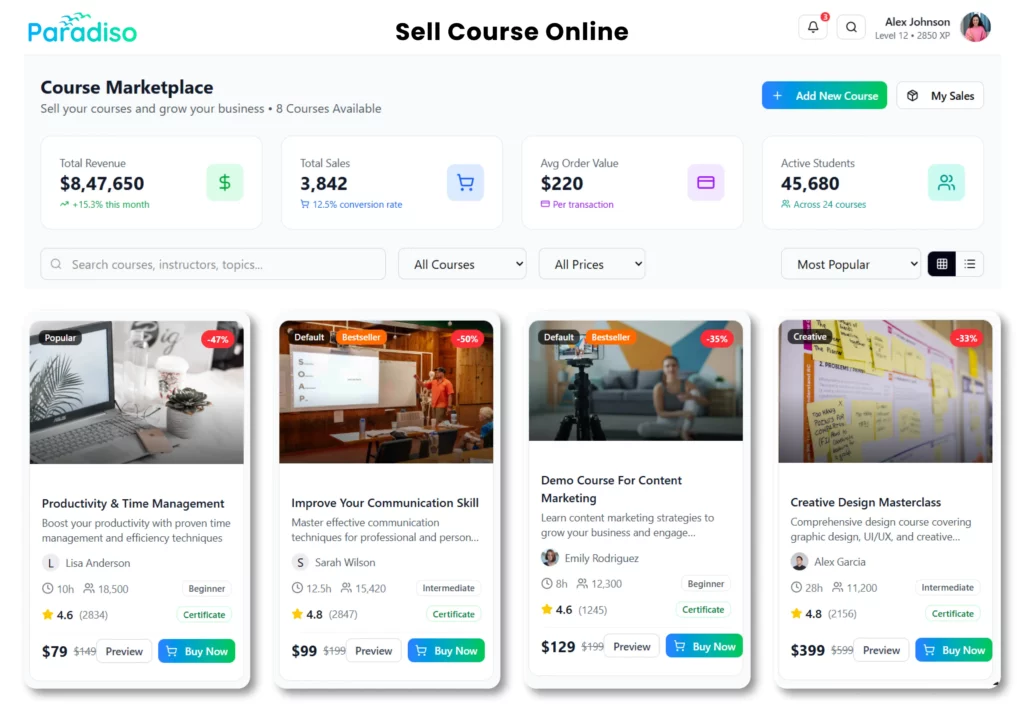After a customer makes a purchase, there are still ways to make more money. You can use clever marketing techniques called cross-selling and upselling to do this.
Cross-selling means suggesting related products or services that customers might be interested in. Upselling means offering customers an upgrade or a better version of what they’re already buying.
Cross-selling vs. upselling benefit both customers and businesses when executing the process correctly. Customers get a better experience, and businesses earn more money. However, it’s essential to be careful not to annoy customers by using these techniques incorrectly or aggressively.
At Paradiso LMS our experienced marketing team has helped many businesses with cross-selling and upselling. We’ve learned a lot from our successes and have shared our knowledge through articles and webinars. In this guide, we’ll provide practical tips and insights to help you make your customers happy, provide more value, and grow your revenue.
What is Cross-Selling?
Cross-selling is all about suggesting extra products or services to customers that complement what they’re already interested in. These additional items are meant to enhance their experience and increase the chances of them buying more. By cross-selling, you not only improve the customer’s satisfaction but also create a cycle of sales that brings in more revenue. It’s like building a chain of purchases that benefits both the customer and your business.
This technique can improve your sales and earnings by 25% to 35%. For instance, let’s say you have a clothing store, and someone wants to buy jeans. To complete the outfit, you can cross-sell other products like T-shirts, trousers, watches, and sandals. Customers who see these additional options are more likely to buy more items. As a result, your average order value (AOV) increases, bringing in more sales and helping your business grow.
What is Upselling?
Upselling is when you recommend a more costly item or service a shopper bought to raise the average order value (AOV). To keep it simple, if someone buys something from your store, you can offer them a better and more valuable version of that item. It gives them more value, helps your brand grow, and brings in more money because it affects your AOV (average order value).
Here’s an example to help you understand better: Let’s say you sell marketing courses for $699. Since it can be difficult for customers to trust a new brand or service, you can offer them two or three video lectures for free or at a small price. It allows them to see the quality of the course. Some may make a higher-priced purchase if they’re happy with the quality.
Let's Find out The Importance of Upselling vs. Cross-Selling in eCommerce
Upselling vs. cross-selling often have a terrible reputation for being sneaky ways to make more money from customers. But that’s only sometimes true. When done right, these techniques can benefit both the customer and the business.
The key is to use these tactics ethically and helpfully. Instead of pushing unnecessary products, the focus should be on suggesting options that meet the customer’s needs. It’s about providing valuable information and guiding them towards the best decision.
So, how exactly do cross-selling or upselling help your business? They allow you to offer additional choices that might be a better fit for the customer. By presenting these options, you can help customers make informed decisions that truly benefit them. It builds trust and customer satisfaction, increasing sales and substantial business.
Remember, it’s all about providing value and assisting customers in finding the right solutions. When done with care and honesty, cross-selling and upselling can be effective strategies for both businesses and customers.
1. Cross-Selling and Upselling Maximize Revenue
We all know that when customers buy more from your business, it means more money for you. That’s why having an excellent cross-selling and upselling strategy is so important.
Your existing customers can be a goldmine for your business. To tap into that potential, using the right words and offering valuable incentives when suggesting additional products or upgrades is crucial. The language you use in your call-to-action (CTA) or lead magnet should spark customers’ interest and provide them with real value.
When you do this right, it builds loyalty and trust in your business. Customers feel like you genuinely care about their needs, and they become more attached to your brand. It leads to more sales and strengthens your brand’s reputation and value.
2. Enhance Customer Loyalty through Upselling and Cross-Selling
Upselling sometimes gets a bad reputation because of pushy car salespeople who try to make customers buy things they don’t need.
But in reality, that’s not how it should be. Upselling is about giving customers all the options and information so they can make the best choice for themselves. It shows that you care about their needs and want to help them.
Customers can be easily influenced and leave if they’re not satisfied. Any strategy that helps build loyalty reduces the risk of losing customers, especially new ones. Happy customers also spread the word about your business, which is the best advertising you can’t buy.
In today’s world, people always check a company’s reputation before doing business with them. Having satisfied customers is the most valuable form of advertising.
3. Boost Your ROI with Cross-Selling and Upselling
After successfully marketing and selling to a customer, take advantage of the opportunity to make the most of it for your business. You’re leaving potential money behind by paying attention to upselling and cross-selling. Take the initiative to offer customers relevant products that enhance their experience and provide added value.
When you suggest additional items or upgrades that align with their interests, you give customers more options. It increases the chances of them buying more and improves their overall satisfaction.
Remember, your customers already trust you and are interested in your offers. By offering them relevant and valuable options, you maximize the value they get from interacting with your business. Take advantage of this chance to increase your sales and enhance the customer experience.
4. Improve Customer Lifetime Value through Upselling and Cross-Selling
Getting a sale from an existing customer is 60% more likely than targeting new customers. So, it’s wise to focus on existing customers first.
By upselling and cross-selling, you can increase the value of each order in the short term and the overall customer value over time.
Here are some cross-selling ideas to boost customer loyalty:
- Send personalized emails suggesting items they might like.
- Offer discounts, special deals, or freebies to incentivize purchases and reward loyalty.
Adding an upsell widget to your e-commerce platform can be affordable and accessible. For example, Paradiso eCommerce LMS offers a post-purchase upsell feature. Building customer loyalty pays off in the long run. It increases the value of their purchases and creates more dedicated customers. You’ll notice a significant difference when dealing with loyal customers.
5. Manage All Customers Through Cross-selling and upselling
To keep your business strong, it’s important to maintain a balance between new customers and those you already have. This balance ensures that your company continues to make money and grow.
One way to achieve this balance is through upselling and cross-selling. When you offer existing customers relevant and helpful products or services, they feel valued and will likely keep buying from you. It shows that your business cares about its needs and wants to provide ongoing support.
By implementing upselling and cross-selling strategies, you increase sales and strengthen customer loyalty. Happy customers who see your business as trustworthy and attentive are more likely to stick around and continue making purchases.
It’s all about finding the right balance between acquiring new customers and nurturing your existing ones for long-term success.
6. Deliver Flexibility for Customers Through Cross-selling and upselling
Upselling and cross-selling benefit not only businesses but also their customers. When looking for a product or service, people often prefer to stick with a brand they already know.
Offering them more choices or relevant add-ons reduces the risk of losing customers to competitors.
Customers stay with a brand they like, especially knowing what else is available. When you gain their trust, you can seize the opportunity to offer related products and services.
By upselling or cross-selling, you provide them with convenience and the freedom to choose, encouraging them to stay with your brand. It’s a win-win situation where customers get more options, and you build a stronger relationship with them.
4 Proven Methods for Cross-Selling and Upselling That Ensure Business Success
A. Shorten choices to enhance upselling
B. Simplify Decision-Making with Product Bundles
When customers have too many choices, it can be overwhelming and make decisions harder. To make it easier for them, offer bundled products that are related and fit their needs. Instead of buying each item separately, they can get everything they need in one package. It saves time and simplifies their decision-making process. By offering bundled options, you can make it more convenient for customers to choose what they want without feeling overwhelmed.
C. Avoid Being Overbearing or Forceful in Your Approach
To enhance the shopping experience, leverage customer data and behavior to offer tailored recommendations that align with their needs and address potential issues. Show social proof by highlighting similar products purchased by others or upgrades chosen by customers. However, it’s crucial to avoid certain practices:
- Only push additional items after they’ve made a selection.
- Keep the options manageable to prevent overwhelming them.
Avoid sneaky tactics like automatically adding extras without their awareness. Honesty and transparency are vital to building trust and providing a positive shopping experience.
D. Maximize Opportunities For Post-Purchase Cross-Selling
Conclusion
Now that you understand the difference between cross-selling vs. upselling, you must learn how to implement these strategies effectively. Paradiso E-commerce LMS offers a user-friendly dashboard and compatibility with popular page builders like Elementor, making it easy to cross-sell and upsell your products.
With Paradiso LMS, you can create customized product pages to present additional offers to your customers. By offering training and educational resources through the platform, you increase revenue and improve customer retention. Customers are more likely to embrace cross-selling and upselling opportunities when they trust your expertise and value your guidance.

























